Eutrochium spp.
Skipping over all the heated arguments about flowers, snobbery, and who has the audacity to call certain plants “weeds,” I’ll tell you that joe-pye weed is wonderful.
It grows tall, seven feet or more, and blooms in late summer and fall when so many other flowers have already faded.
Its composite flowers, in attractive shades of purple, pink, and pearl white, have a scent reminiscent of vanilla.
They produce an abundance of nectar and pollen that attracts and provides for butterflies, particularly swallowtails, and various other types of pollinators.
The seeds, especially since they form so late in the fall, appeal to songbirds in search of food.
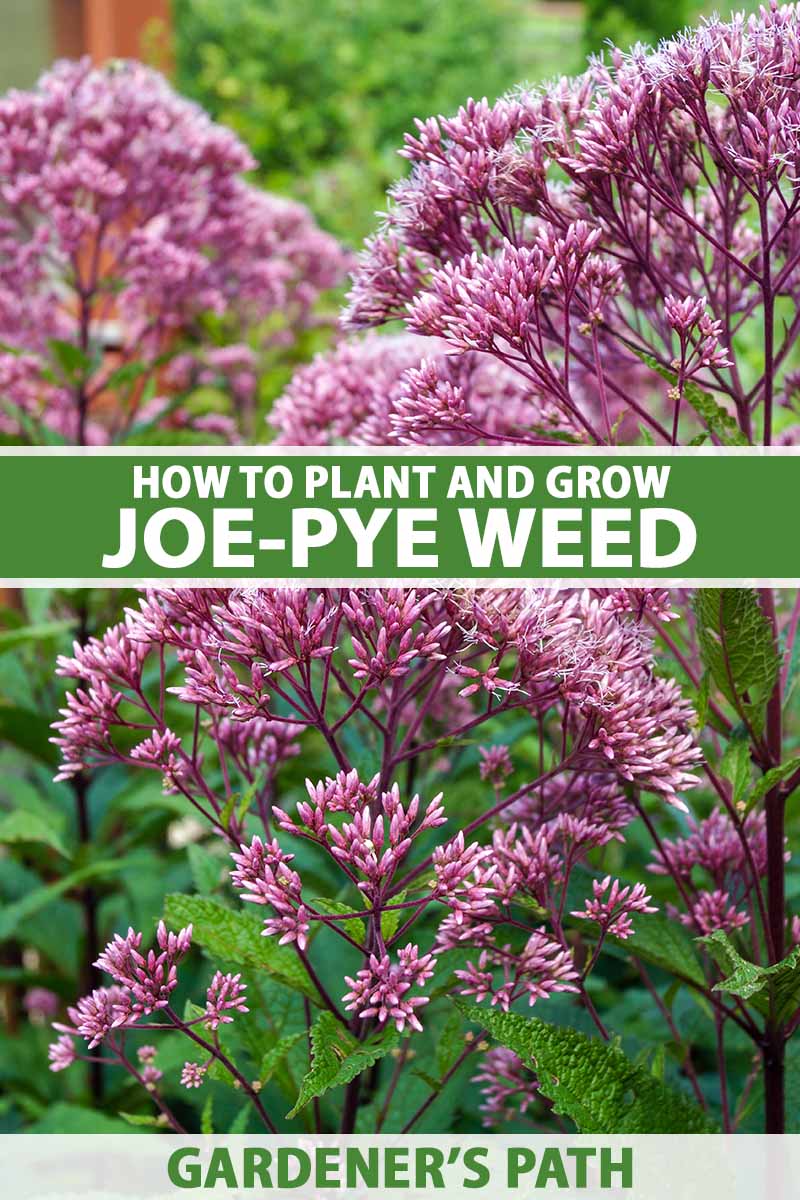
We link to vendors to help you find relevant products. If you buy from one of our links, we may earn a commission.
Joe-pye has a couple of especially desirable traits you don’t come across that often.
For one thing, it will thrive in moist areas, which is why you may have spotted it growing in ditches alongside the highway, and why you might want to plant it in problematic swampy areas of your yard.
And its USDA native status extends throughout the lower 48 states, so it’s appropriate for meadows, butterfly gardens, and other native landscaping plots across the country.
Whether you’re looking for a tall plant that’s easy to care for, or you’re trying to attract wildlife and love a vanilla aroma, joe-pye weed may be just the thing.
There are even more benefits to discover in this guide, along with plenty of growing advice. Here’s what to expect:
What You’ll Learn
What Is Joe-Pye Weed?
Part of the aster family, Asteraceae, and native to North America, the five species commonly called joe-pye weed are late summer and fall-blooming wildflowers that thrive in sunny, moist sites.
They readily self-seed, and some species also spread underground via rhizomes.
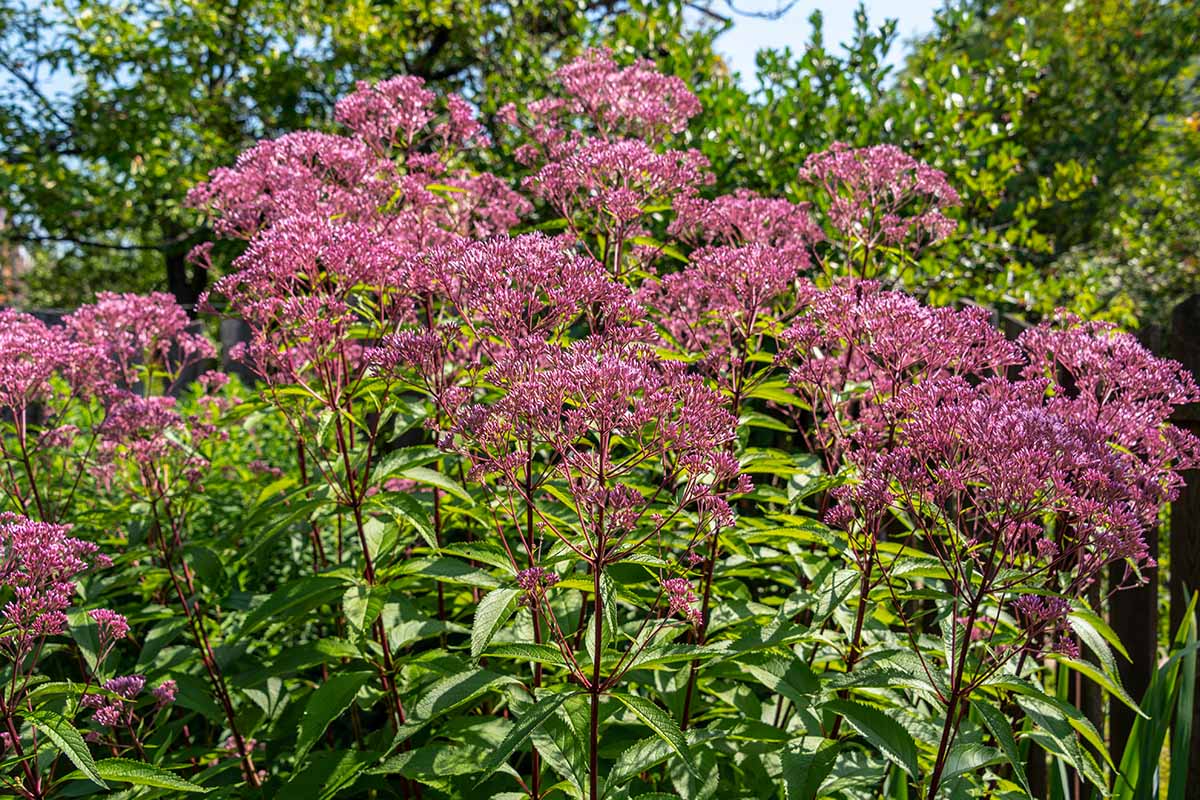
Most grow tall, to a mature height of seven feet or more, but some of the cultivars developed more recently are shorter and more appropriate for smaller garden beds, reaching three to five feet tall.
They typically bloom in purple or dusky white, though some varieties have off-white blossoms.
Each flower is a composite, flat-topped cluster of nine to 22 tubular florets with a pithy center.
Along with being irresistible to bees, the abundant nectar attracts hummingbirds, and songbirds flock to the blooms to eat the insects they draw.
When the flowers fade in late fall, they produce seeds for the birds to eat, and little fluffy puffs (known as pappi) that may be used as nesting material.

All these traits make joe-pye a darling of naturalists and gardeners in search of hardy native plants for the fall landscape.
How did this species get such an unusual name? Read on for more info about that, and learn all the dos and don’ts for growing this wonderful wildflower.
Cultivation and History
I love a good story as much as the next person, but it’s most likely just folklore that the original Joe Pye was a native healer who would cure typhus with Eupatorium purpureum.
That plant was once classified in the same genus as joe-pye weed, and is now known commonly as boneset (Eupatorium perfoliatum).
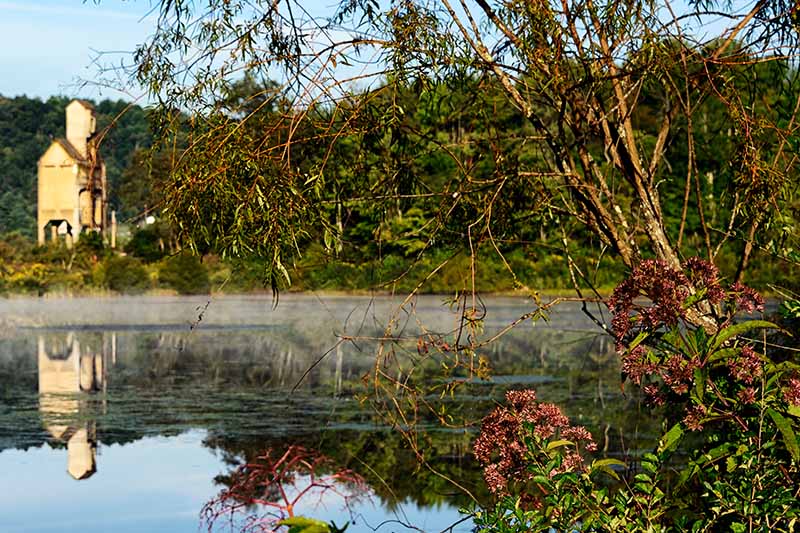
The tale of the New England herbal healer has been making the rounds of wildflower guidebooks for at least 120 years.
Another amusing but unlikely addition to the background of this species says the former genus Eupatorium has a name derived from a king known as Eupator Dionysius.
He was born around 120 BC, and may have used a poison antidote derived from plants of that type to condition himself to withstand the effects of poison later used to kill his enemies.
Some recent and aboveboard research from botanists James S. Pringle and Richard B. Pearce did establish the existence of an authentic Joe Pye.
That was the nickname used by Joseph Shauquethqueat, a venerable Mohican chief who lived in New England in the late 1700s and early 1800s.
So far, though, the relevance of this chief’s connection to the plant species has not been conclusively established.
The catchy common name has been applied to these wildflowers since at least 1818, when it was recorded in Amos Eaton’s work, “A Manual for Botany for the Northern and Middle States.”

A Manual for Botany for the Northern and Middle States
If you’re curious, you can find this book on Amazon.
In the intervening centuries, many more species of joe-pye weed have been identified. In a bold and sweeping move, botanical taxonomists made a necessary distinction in 2012, moving five species associated with this moniker to the genus Eutrochium.
Mind you, there are still plenty of herbalists today who will tell you about that typhus-curing connection, and many of those who sell or describe these plants still use the Eupatorium label. (I think of this as being similar to some who never converted to the metric system, not as evidence of ill intent.)
Today, whatever the path taken to arrive at that name may have been, these plants are widely appreciated as part of an “old is new again” movement towards native landscaping, and creating pollinator and butterfly gardens.
You can appreciate this appealing though inconclusive backstory, the tough nature of these naturalized plants, their late-blooming show of color, or all of the above.
Whatever draws you to wanting to grow your own healthy joe-pye plants, be it the name or the benefits, we’ve got the step-by-step instructions right here. Let’s get growing!
Joe-Pye Weed Propagation
To grow your own joe-pye weed, you’ll need a site that has ample moisture and receives full sun to part shade – more light is preferred, for abundant blooms.
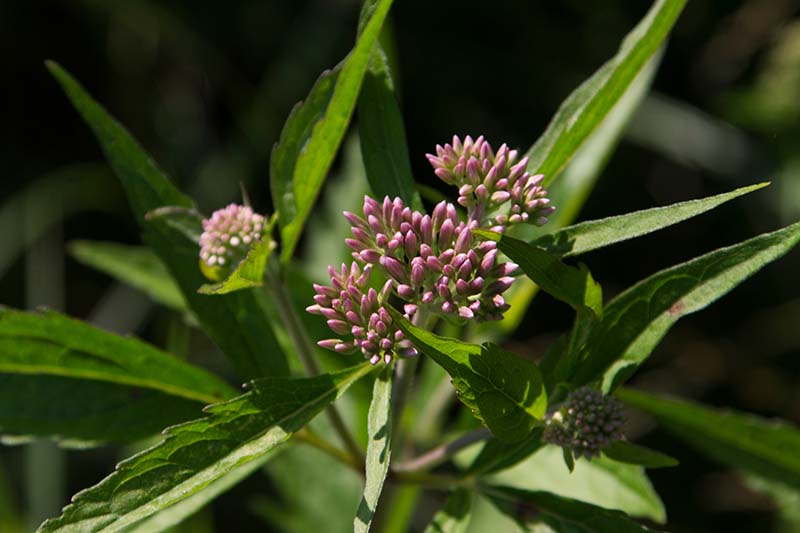
The soil should be fertile and amended with plenty of compost, whether loam or clay. With those requirements in place, here’s how and when to plant:
From Seed
Unless you have a handy source of divisions, or are content with purchasing a few nursery plants, the best way to start more than a couple of these statuesque wildflowers at a time is by planting seeds.
To most closely mimic the natural growing conditions for these native plants, sow the seeds in late summer or early fall, so they can chill properly during the cold months. Keep them moist until they sprout in early spring.
To sow, press them into the surface of soil that has been cultivated a few inches down. They need light to germinate, so don’t cover them with soil.
Plant about seven seeds in groups two or three feet apart, to accommodate joe-pye weed’s low germination rate.
If more than one seed does sprout in a given spot, when the seedlings produce two pairs of true leaves, you can clip the smallest at the soil line and leave the healthiest to grow on.
The final spacing should allow between two and four feet between plants, depending on the variety.
You may want to apply a lightweight row cover after planting to keep birds from eating the seeds.
Late summer or fall-planted seeds will sprout in early spring. They may bloom that first year, but don’t worry if they hold off until their second growing season to produce flowers. Either timeline is within their typical range.
You can start seeds indoors, but then you’ll need to provide the seeds with the requisite period of “cold stratification,” instead of relying on the wintry weather.
That just means pressing the seeds into the surface of pots of moist soil, popping them into plastic zipper bags, pots and all, and leaving them in the fridge for 30 to 60 days before growing them indoors to plant out in spring.
It’s also possible to store just the seeds in the fridge from fall until spring temperatures are suitable for outdoor sowing, but it’s less likely you’ll get blooms in the first year with this approach.
From Divisions
Divisions can be made from your own mature plants, or you can source donations from a friend.
Make sure your garden bed or other area of the landscape is already prepared with compost and moist soil to receive the new plant.
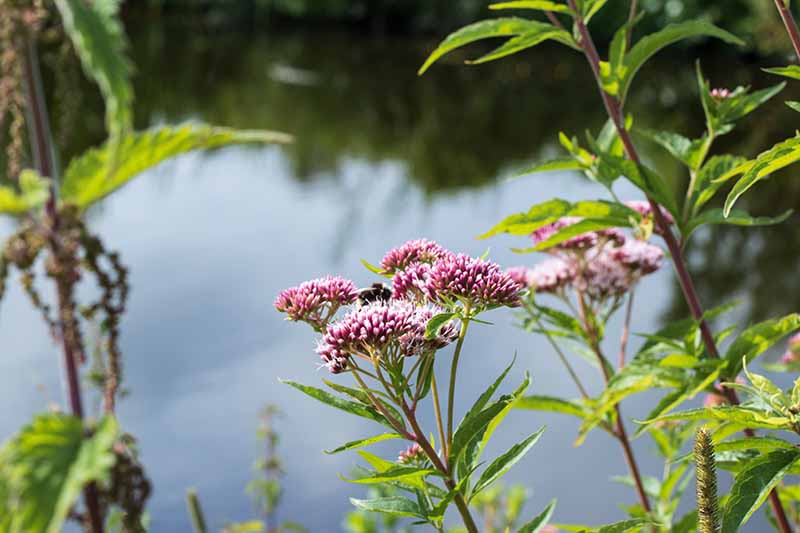
The stems can only survive out of the ground for a few hours after dividing, and even then you’ll need to wrap the roots gently in a moist towel until you can get them into the soil.
To propagate joe-pye weed from divisions, divide mature plants in the fall as they go dormant. Or, you can wait to divide them until the spring when they begin to send up shoots.
Use a spade to dig out the whole plant and rest it on the ground.
Look for the wide crown of the mature plant. It will have several stems and a tangled root system.
Each piece of stem can become a new plant, but only take half of the total plant for divisions at most, so the parent plant can adjust more readily.
Thrust a sharp-ended trowel downward a couple of inches to separate a stem from the crown, cutting the attached roots at the same time. Gently bring that piece to the surface, and then replant it in its new location.
Plant it at the same depth it was growing when it was part of the parent plant.
Water it in and apply a couple of inches of pesticide- and herbicide-free mulch in a circle a couple inches away from the stem, to keep the soil moist until the plant gets established.
Unless you’re trying to relocate it as well, set the parent plant back in its original hole, and take this opportunity to add a bit of compost when you backfill the opening.
From Transplants
If you buy plants from a nursery or grow seedlings indoors, you can add them to the landscape or garden in late summer or early fall.
To transplant, prepare the bed as you would for seeds or divisions.
Dig a hole for each plant that’s at least three feet from its nearest neighbor, and a little larger than the root ball of your transplant.
Gently tip the plant out of its pot and set it into its hole with the top of the root ball positioned at soil level. Add the same rich, compost-amended soil to fill the hole, tamp lightly, and water deeply at the soil line – not from overhead.
You may also want to mulch transplants with a couple inches of organic material that hasn’t been treated with potentially harmful chemicals, like straw.
Place it a few inches from the center stem. This will help to keep moisture in without killing off the pollinators this wildflower attracts in swarms.
How to Grow Joe-Pye Weed
You’ve been promised practically carefree plants, and joe-pye will deliver.
You will need to keep seedlings moist for the first year until they get established, but after that, they can survive a dry spell now and then.
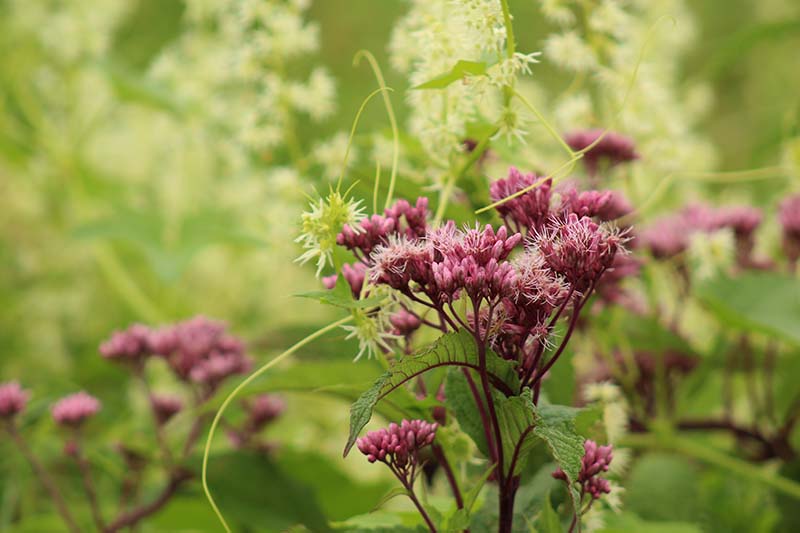
Just make sure to give the plants about an inch of water if it hasn’t rained in any given hot-weather week.
If you’ve planted them in the woods or a meadow, don’t worry about fertilizing these wildflowers.
But when you’re growing in poor or average soil in a garden bed, they will benefit from a side dressing of compost or an application of slow-release fertilizer. Do this chore in early spring, as the perennials are sending up new shoots.
One more thing: Weeds are a problem for young seedlings. They will compete for the water the plants need.
Mulch will keep the weeds down while helping to retain moisture in the soil. If weeds do appear, make sure to pull them.
Growing Tips
- Plant in full sun to part shade.
- Press seeds into the soil surface – they need light to germinate.
- Only grow where the plants will have three feet to spread.
- Keep the soil moist, especially in the first year.
- Prevent weeds with mulch.
Pruning and Maintenance
One maintenance chore when growing joe-pye involves constant deadheading, if you’d prefer that your plants not self-seed.
Note that this won’t encourage new blooms the way it would for some other types of flowers, like bachelor’s buttons, but you will be able to prevent aggressive spreading if that’s your wish.

Wait for the flowers to die first, but perform this task before they become brown and dry, and produce seeds the wind is only too happy to carry to exposed earth elsewhere in the yard or garden.
I’m not the type to fuss like this over a native plant, and I consider their impressive height to be an asset, but some gardeners also like to prune joe-pye a bit later in the growing season.
Clipping the top third of the plants will encourage them to branch more fully and attain a shorter height.
As the blooming season comes to a close, if you object to the appearance of sprawling, dried-up wildflowers in your landscape, you can also trim the spent plants without hurting them.
Do this in late autumn, using clippers and leaving the bottom four to eight inches in place.
Joe-pye goes dormant in the winter, and the leaves will turn black after a hard frost or two. You can clip them at this point if you like, but it’s strictly cosmetic, since the wildflower will grow back with or without the unsightly dead foliage attached.
When your plants are part of a native landscaping scheme or a wildlife garden, you may want to forgo cutting down the dry stalks and leaves.
They provide shelter for songbirds in cold weather, and the stalks give beneficial insects a spot for overwintering.
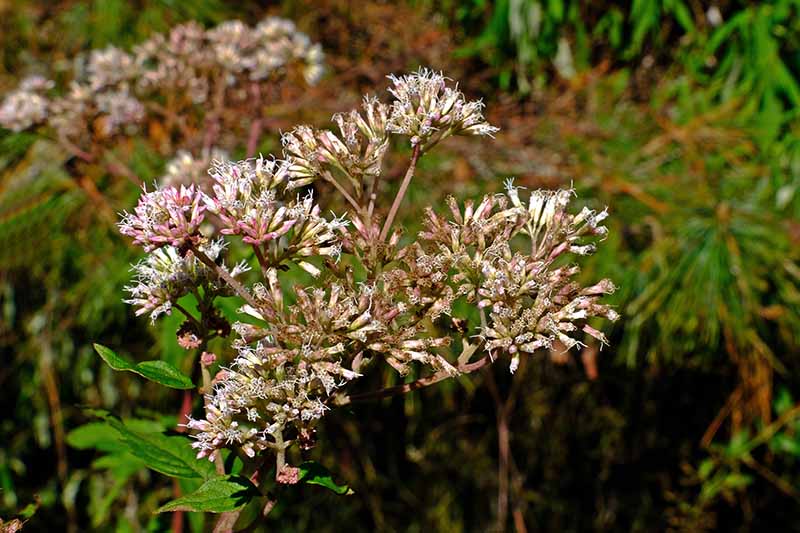
Other than clipping for cosmetic reasons, these species are hardy wildflowers, and they can pretty much take care of themselves over the winter.
Once they’re three years old, and every few years after that, it’s a good idea to divide them. This will keep the root mass from growing so large that the center of the plant dies off because it’s no longer getting the nutrients it needs.
Dividing is also a good way to stop the plants from spreading too far, or for providing yourself with some starts for transplant.
Time the job for early spring, just as they’re sending up new growth.
With a sharp-edged spade, dig out the entire plant, along with an extra two inches of soil around the perimeter. Thrust the spade into the ground at a right angle, moving all around the plant until the root mass can be lifted.
Ease the whole plant and its root system out of the ground in one big clump.
Then lay it on the soil next to the hole, and use a pruner or soil knife to sever the roots into several pieces, making sure each has stalks attached.
Wearing gloves, gently work the pieces free of each other. Transplant them immediately, following the directions outlined above.
And hey, if you’re the type who can’t wait to plant more and more joe-pye and would like to save seeds in addition to making divisions, you can do that as well!
Start about a month after the flowers have stopped blooming, once you can see that they’re dry and brittle and have turned brown. Use scissors to sever the entire seed head from the stalk.
Place it into a brown paper bag and set it in a cool, dry spot for about three more days to dry completely.
Pluck the seeds off the heads and store them in the fridge in a zipper bag, small canning jar, or plastic container. Leave the seeds in the refrigerator right up until you’re ready to plant next season.
Species and Cultivars to Select
While there are also some unique cultivars available, some of them bred to resist powdery mildew, these four species within the Eutrochium genus offer a good place to start when you are selecting a type to grow.
Botanical taxonomists moved each of these from the genus Eupatorium in 2012, which is so recent that you can still expect many people to refer to them by their former names.
Each of these is commonly referred to as “joe-pye weed,” with perhaps another more specific nickname in use as well, and has a few distinct characteristics to consider. Here’s the scoop:
E. dubium
This species has the intriguing alternative name of “three-nerved joe-pye weed.” A dwarf species that usually grows just three to five feet tall, it can thrive in smaller areas, but still spreads between two and four feet.
The stems are purple-spotted, the leaves are yellowish-green with three deep veins apiece, and the flowers form domed clusters of pale pink to purple florets that are four to seven inches wide.
E. dubium plants are hardy in Zones 4 to 8. ‘Little Joe’ plants are available from Burpee.
E. fistulosum
Known as hollow stem joe-pye weed, E. fistulosum sports muted pink or purplish flowers in clusters that can reach 18 inches across. It’s a butterfly smorgasbord with all that nectar.
The plants grow four to 10 feet tall and spread two to four feet. They are hardy in Zones 4 to 8.
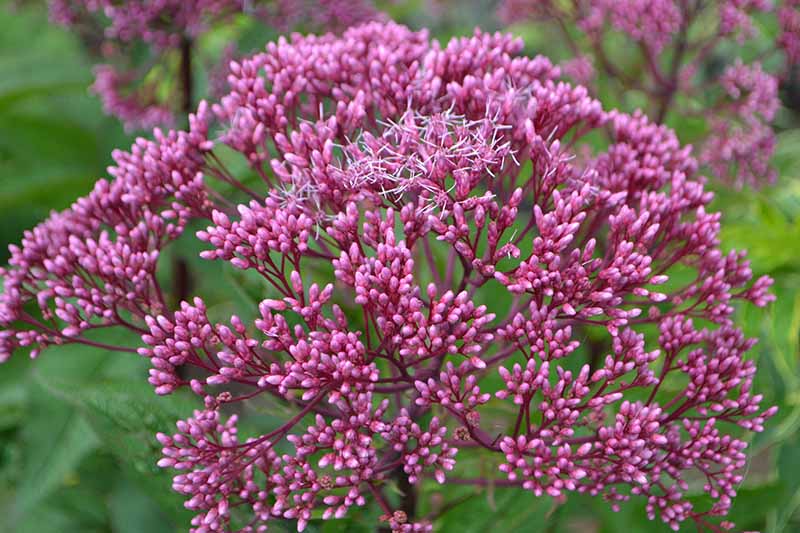
As for that nickname, the smooth, light green stems are indeed hollow. If you leave them alone and let them dry at the end of the season, solitary bees will sometimes seek them out as a place to reside and lay eggs.
‘Alba’ is an attractive option, with white flowers if you’re looking for something a little different.
E. maculatum
Referred to as spotted joe-pye weed, this variety has stalks that are purple or green with purple speckles, hence the nickname.
The mauve or purple flower heads are nearly flat.
E. maculatum is hardy in Zones 4 to 8, and grows three to six feet tall.

“Seed bombs” that include seeds, compost, and soil are one buying option for this variety. They are available in 20-, 50-, 100-, and 200-seed ball packets from Seed-Balls.com via Amazon.
Sometimes listed under other species names, ‘Gateway’ is a popular cultivar.
Read more about growing E. maculatum here.
E. purpureum
Monarchs are just one of the types of butterfly that find E. purpureum so appealing. The vanilla scent is particularly strong in this variety, and the aroma wafting on the breeze attracts butterflies and other pollinators.
Hardy in Zones 4 to 9, this plant, commonly referred to as sweet joe-pye weed, grows to between three and seven feet tall. Its textured leaves are grouped three or four to a whorl, on green stalks.
The leaf joints are purple and they sport delicate hairs.
E. purpureum seeds are available in 120-seed packets from Zellajake Farm and Garden via Amazon.
Managing Pests and Disease
This easy-care wildflower is mostly free of insect problems, and is even resistant to those persistent four-footed pests, the deer and rabbits.
It also eludes most diseases, though you’ll want to watch out for powdery mildew, caused by Golovinomyces orontii.
This fungus can overwinter in soil and spreads its spores via wind. It thrives in high temperatures and intense humidity.
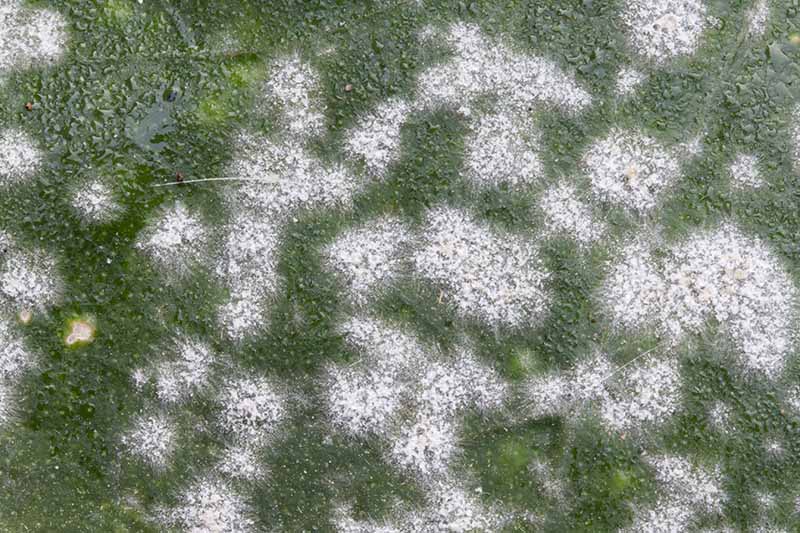
Powdery mildew will appear on foliage as patches of gray-white mildew, and it can harm the wildflower’s ability to get the nutrition it needs via photosynthesis.
To avoid powdery mildew, make sure your plants have plenty of room to grow. Ample air circulation will stop this fungal infection before it starts.
Also avoid watering from overhead, to keep relative humidity lower near the susceptible foliage.
When you grow joe-pye in part shade, there’s a higher risk of powdery mildew, which prospers in low-light conditions. If it’s a persistent problem, consider moving your plants to a sunnier spot.
To keep powdery mildew from obliterating plants that are growing in less substantial light, make sure to observe them often, especially when humidity becomes a factor in the warm months.
If just a few leaves are affected when you notice the splotches, you can clip them off and dispose of them in the trash, and that will probably take care of the problem.
Should you only spot powdery mildew after it’s established a stronghold, fungicides like neem oil can be effective.

Safer Brand Horticultural & Dormant Spray Oil
Safer Brand Horticultural & Dormant Spray Oil Concentrate is a good option for organic gardens. It’s available in a 16-ounce concentrate from Safer Brand via Amazon.
Though it is not considered common, a 2006 report noted that wild joe-pye weed may serve as a host to tobacco ringspot virus, and the virus can live on plant debris and seeds.
This disease may be transmitted via contaminated tools or hands, and it causes stunted growth, yellowing, and a mottled appearance on leaves, as well as leaf rolling.
Affected plants should be removed from the garden and destroyed.
Best Uses for Joe-Pye Weed
When you’re employing joe-pye in your garden or landscape, if you have space and can keep the plants moist, the best uses are limited only by your imagination.
Each plant must have at least a couple of feet between it and the nearest plant, wall, or tree, with ample moisture.

Beyond that, though, it’s a beautiful and beneficial addition to native plantings, butterfly gardens, and perennial meadows.
Use the height to complement shorter flowers or ornamental grasses in complementary colors.
This wildflower blooms late in summer and fall, so consider it to continue the show of color when short-season annuals in the garden have gone to seed.
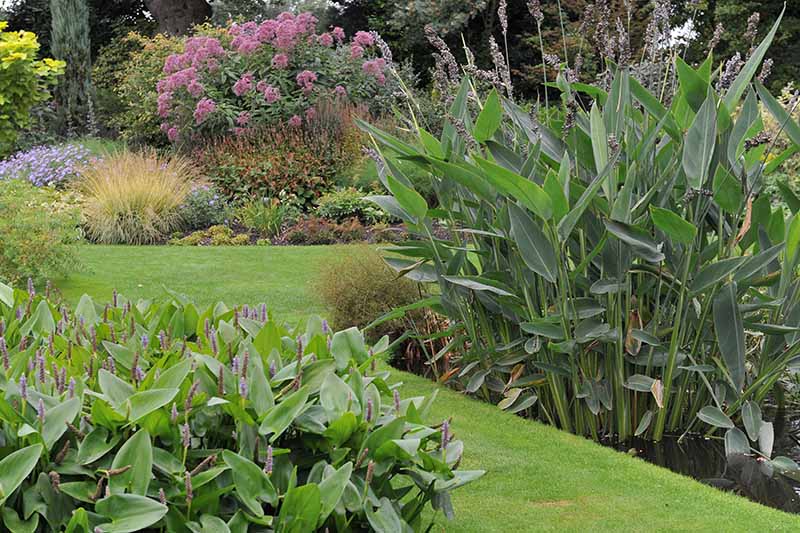
It’s also an MVP at the back of borders or, with its affinity for wet soil, it can be planted in a swampy patch of yard. Consider growing it near a rain spout to disguise the eyesore while the roots drink up any standing water.
One other tip: If you’re employing this pollinator- and songbird-magnet to attract wildlife, see if you can’t place it within view of a window, patio, or porch. That makes it easy to watch the pollinator show from a comfy spot.
Quick Reference Growing Guide
| Plant Type: | Perennial wildflower | Flower / Foliage Color: | Pink, purple, white / green |
| Native to: | North America | Maintenance: | Low |
| Hardiness (USDA Zone): | 3-9 | Tolerance: | Wet soil, drought once established |
| Bloom Time: | Late summer-early fall | Soil Type: | Clay or loam, high in organic matter |
| Exposure: | Full sun-part sun | Soil pH: | Below 8.0 |
| Time to Maturity: | 1-2 years | Soil Drainage: | Moderate to moist |
| Spacing: | 3-4 feet | Attracts: | Bees, birds, butterflies, hummingbirds |
| Planting Depth: | Soil surface (seeds), root ball top even with soil line (transplants) | Companion Planting: | Fellow moisture-loving perennials, ornamental grasses |
| Height: | 4-7 feet | Best Uses: | Beds, borders, native plantings, moist areas in the garden |
| Spread: | 3-4 feet | Family: | Asteraceae |
| Water Needs: | Moderate | Genus: | Eutrochium |
| Common Disease: | Powdery mildew, tobacco ringspot virus | Species: | Dubium, fistulosum, maculatum, purpureum, steelei |
The Not-So-Average Joe-Pye Weed
If you’re used to high-maintenance flowering plants that are stingy about producing flowers, joe-pye can take some getting used to.
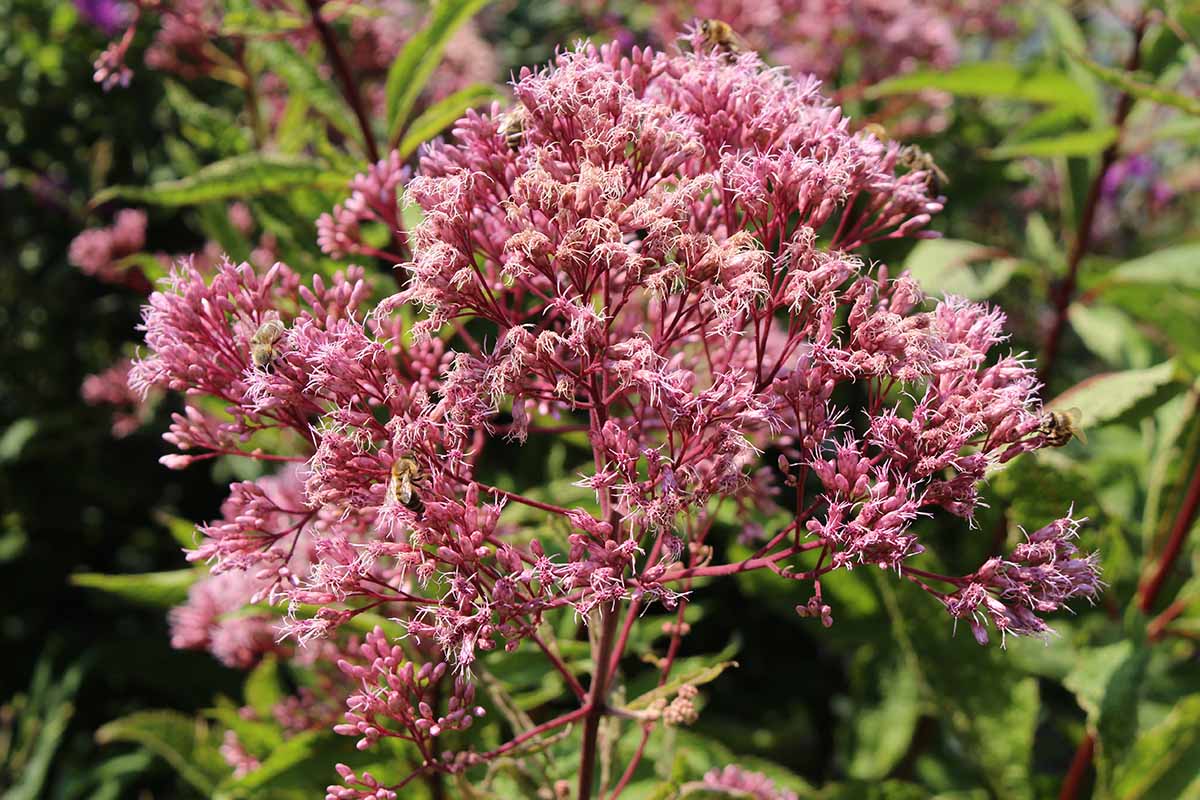
Once established, these plants require almost no maintenance to return year after year with bountiful blooms.
And they provide nectar and pollen for a host of wildlife, not to mention their problem-solving capacity.
I can’t recommend them enough as a solution for high-moisture areas, or spots in the landscape or garden where deer or rabbit damage is nearly impossible to avoid.
What about you? Do you have experience with or feelings about our old friend joe-pye? The comments section below awaits your input!
And for more information about growing flowers in your garden, check out these guides next:
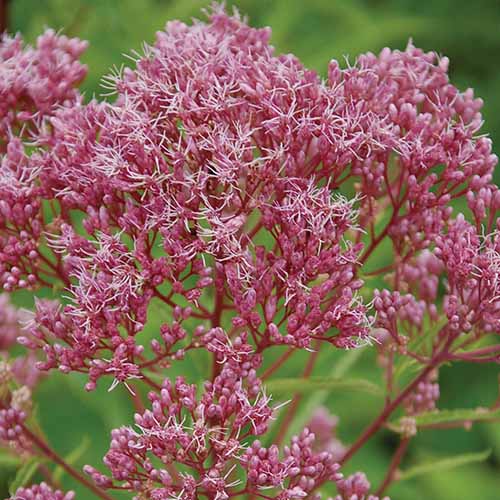
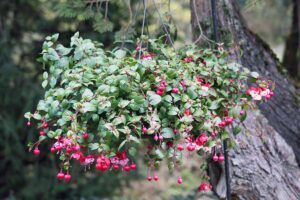
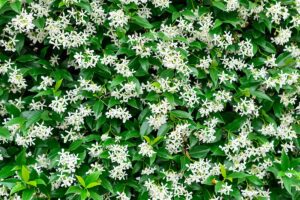
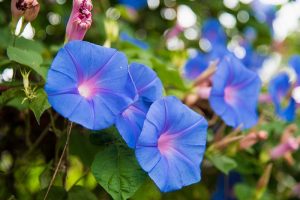
I’ve always loved this plant. If I had a sunny wet spot in the yard I’d plant a lot of it.
Mine is in a sunny dry spot at the back of a garden that slopes downward and it does great
Just planted a foot high plant a few days ago and something already ate all the leaves except the bottom 2 😭 Hope it can still make it!
Hi Lisa, and good luck with that! Maybe plant a few seeds in there, too, to multiply your chance of success? Let us know how it goes!
I’ve been growing Joe Pye (Baby Joe) for about 5 years in my garden. Over the last 2 years I’ve had a terrible problem with powdery mildew that has also spread to the Monarda. I’m using Neem this year to see if I can control it. Fingers crossed. Butterflies absolutely love these as well as bumble bees. Deer or rabbits do not seem interested.
Hello Steven! Happy to meet a fellow joe-pye fan! Hoping the neem oil works. It may also help to give them a bit more space between the plants to prevent at least some of the powdery mildew. I’ll keep my fingers crossed for you, too, and thanks for the recommendation on a plant that is not beloved by deer or rabbits.
I’ve tried several times to grow joe pye from seed but haven’t been successful. I finally broke down and bought two plants that I will plant this week. Good to know that the deer may not be interested in them. We’ll see. I’m still going to build my usually Plant Fortress around them
Hello Lazy K! I sure hope the starts work out for you. And I admire your proactive Plant Fortress approach–which doesn’t sound at all Lazy to me. You just never know with deer, do you? Let us know how it goes if you’d be so kind.
Thank you for such great information! I’m so fortunate to border USACE property where I’m not allowed to touch a thing. It’s wild and wonderful and Joe-Pye Weed flourishes. This year, the plant reached 11.5 feet!
Wow, Chris! I am so glad to hear about this thriving joe-pye.
During the lockdown, I saw joe-pye plants at Lake James state park in Nebo, N.C. and they were a source of beauty and comfort, as you can see:
I don’t think they were quite 11.5 feet though!
Thanks for sharing.